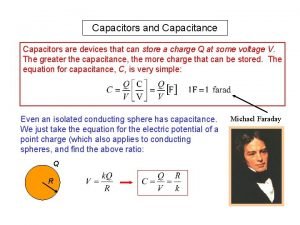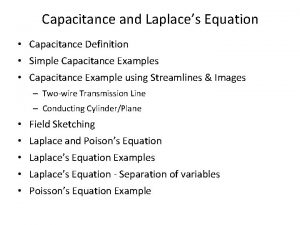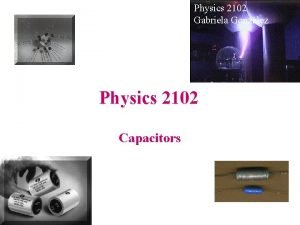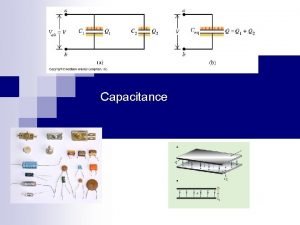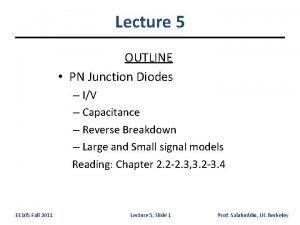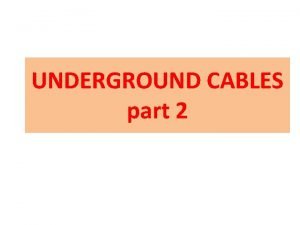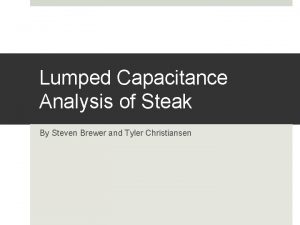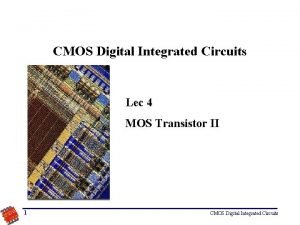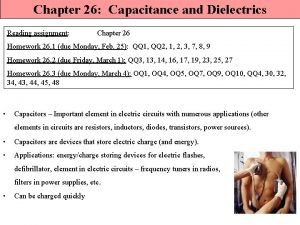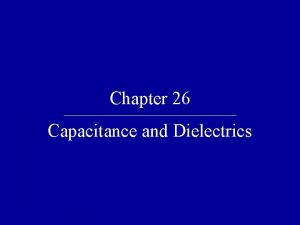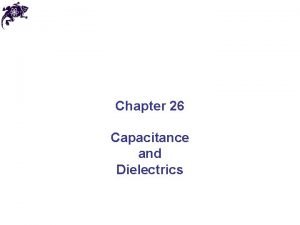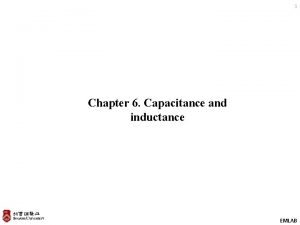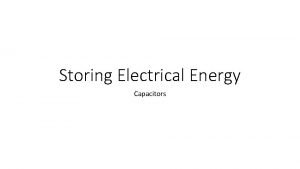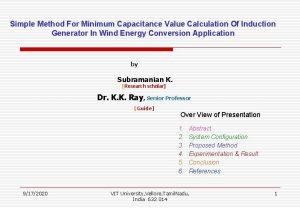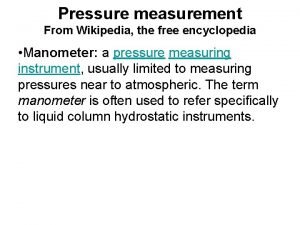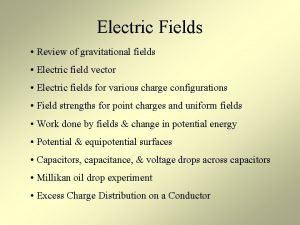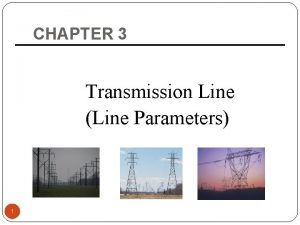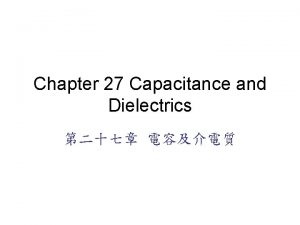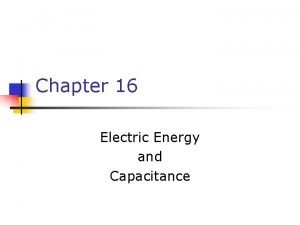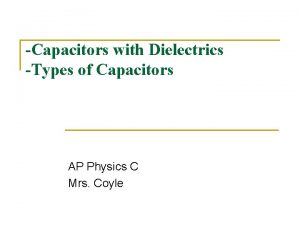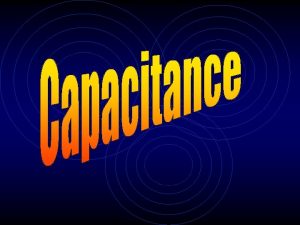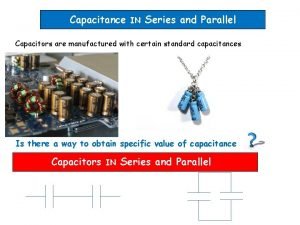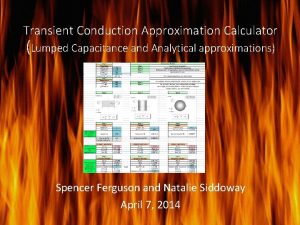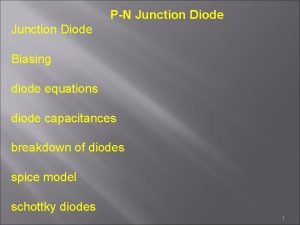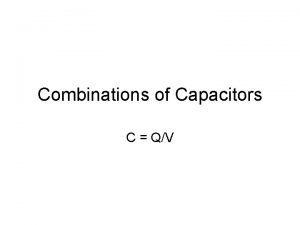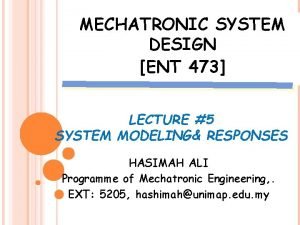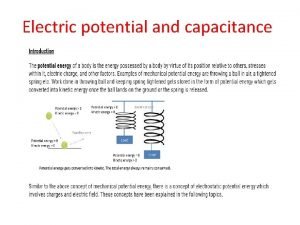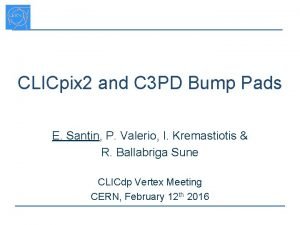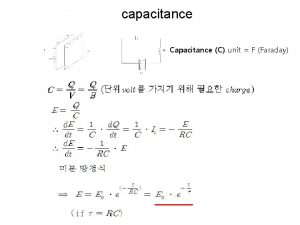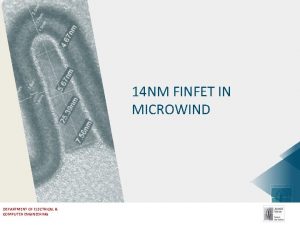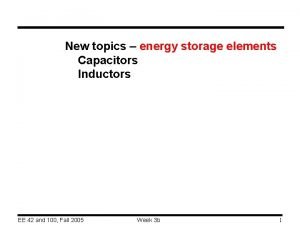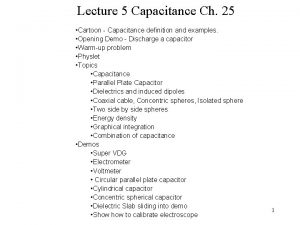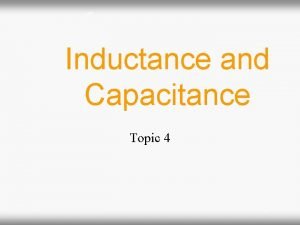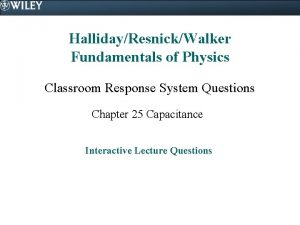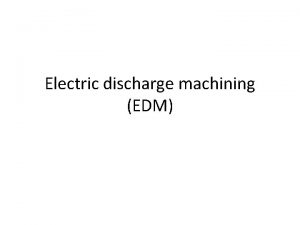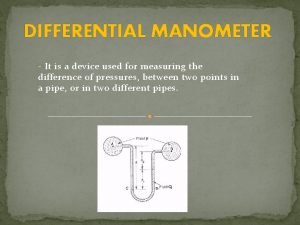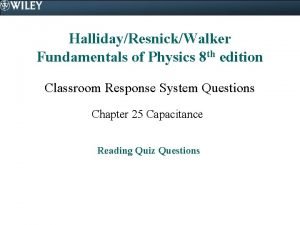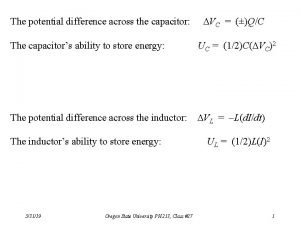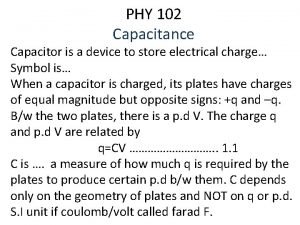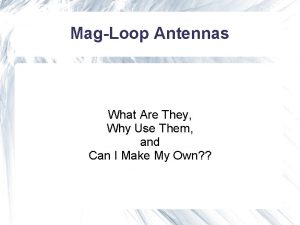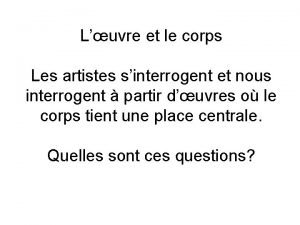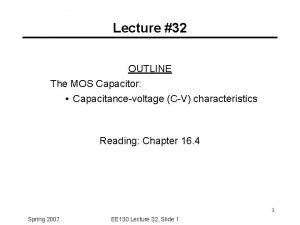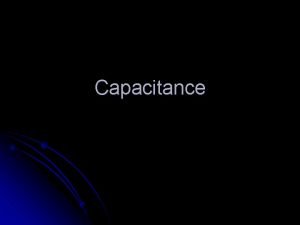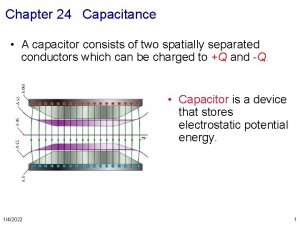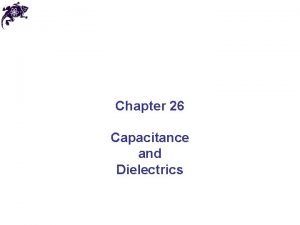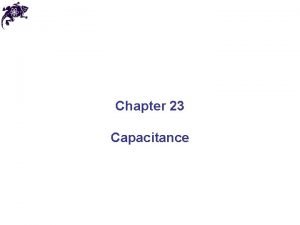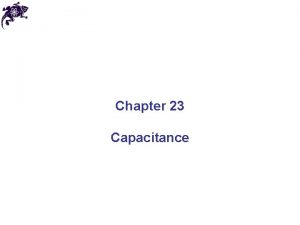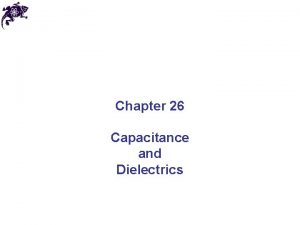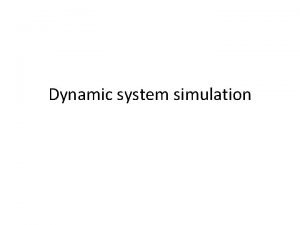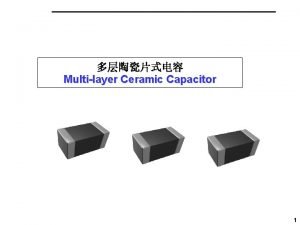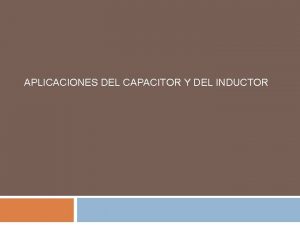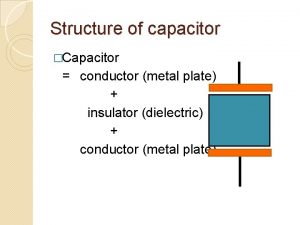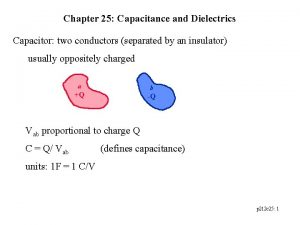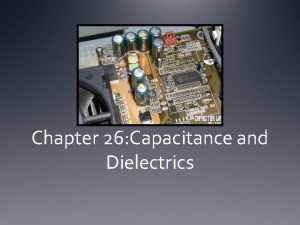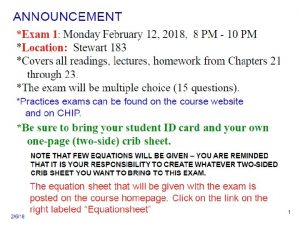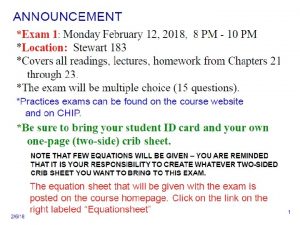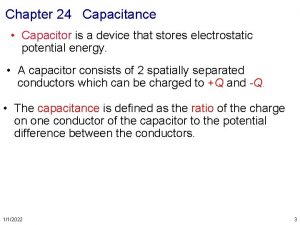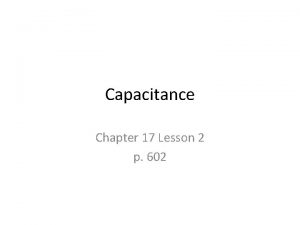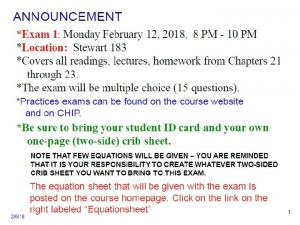Capacitance Chapter 25 Capacitance A capacitor consists of















































- Slides: 47

Capacitance Chapter 25

Capacitance A capacitor consists of two isolated conductors (the plates) with charges +q and -q. Its capacitance C is defined from where V is the potential difference between the plates.

Capacitance depends only on the geometry of the plates and NOT on their charge or potential difference. A parallel-plate capacitor, made up of two plates of area A separated by a distance d. The charges on the facing plate surfaces have the same magnitude q but opposite signs As the field lines show, the electric field due to the charged plates is uniform in the central region between the plates. The field is not uniform at the edges of the plates, as indicated by the “fringing” of the field lines there.

Capacitance - Charging When a circuit with a battery, an open switch, and an uncharged capacitor is completed by closing the switch, conduction electrons shift, leaving the capacitor plates with opposite charges.


Calculating the Capacitance Our goal is to calculate the capacitance of a capacitor once we know its geometry. We will develop a general plan to simplify the work. A charged parallel-plate capacitor. A Gaussian surface encloses the charge on the positive plate. The integration is taken along a path extending directly from the negative plate to the positive plate.

Calculating the Capacitance Calculating electric field To relate the electric field E between the plates of a capacitor to the charge q on either plate, we shall use Gauss’ law: We draw a Gaussian surface that encloses just the charge q on the positive plate. E is uniform and parallel to d. A, so A charged parallel-plate capacitor. A Gaussian surface encloses the charge on the positive plate. The integration is taken along a path extending directly from the negative plate to the positive plate.

Calculating the Capacitance Calculating potential difference the potential difference between the plates of a capacitor is related to the field E by Letting V represent the difference Vf = Vi , we can then recast the above equation as: We will apply this general expression to 4 particular cases. A charged parallel-plate capacitor. A Gaussian surface encloses the charge on the positive plate. The integration is taken along a path extending directly from the negative plate to the positive plate.

Calculating the Capacitance Parallel-Plate Capacitor We assume that the plates of our parallel-plate capacitor are so large and so close together that we can neglect the fringing of the electric field at the edges of the plates, taking E to be constant throughout the region between the plates. where A is the area of the plate. And therefore, A charged parallel-plate capacitor. A Gaussian surface encloses the charge on the positive plate. The integration is taken along a path extending directly from the negative plate to the positive plate.

Concept Check - Capacitors Capacitor C 1 is connected across a battery of 5 V. An identical capacitor C 2 is connected across a battery of 10 V. Which one has the most charge? +Q –Q 1. C 1 2. C 2 3. both have the same charge 4. it depends on other factors

Concept Check - Capacitors Capacitor C 1 is connected across a battery of 5 V. An identical capacitor C 2 is connected across a battery of 10 V. Which one has the most charge? +Q –Q 1. C 1 2. C 2 3. both have the same charge 4. it depends on other factors Since Q = C V and the two capacitors are identical, the one that is connected to the greater voltage has the most charge, charge which is C 2 in this case.

Concept Check – Capacitors (2) What must be done to a capacitor in order to increase the amount of charge it can hold (for a constant voltage)? 1. increase the area of the plates 2. decrease separation between the plates 3. decrease the area of the plates 4. either (1) or (2) 5. either (2) or (3) +Q –Q

Concept Check – Capacitors (2) What must be done to a capacitor in order to increase the amount of charge it can hold (for a constant voltage)? 1. increase the area of the plates 2. decrease separation between the plates 3. decrease the area of the plates 4. either (1) or (2) 5. either (2) or (3) +Q –Q Since Q = C V, V in order to increase the charge that a capacitor can hold at constant voltage, one has to increase its capacitance Since the capacitance is given by , that can be done by either increasing A or decreasing d.

Concept Check – Capacitors (3) A parallel-plate capacitor initially is at a voltage of 400 V and stays connected to the battery. If the plate spacing is now doubled, what happens? +Q –Q 1. the voltage decreases 2. the voltage increases 3. the charge decreases 4. the charge increases 5. both voltage and charge change

Concept Check – Capacitors (3) A parallel-plate capacitor initially is at a voltage of 400 V and stays connected to the battery. If the plate spacing is now doubled, what happens? +Q –Q 1. the voltage decreases 2. the voltage increases 3. the charge decreases 4. the charge increases 5. both voltage and charge change Since the battery stays connected, the voltage must remain constant ! Since , when the spacing d is doubled the capacitance C is halved. And since Q = C V, V that means the charge must decrease

Concept Check – Capacitors (4) A parallel-plate capacitor initially is at a voltage of 400 V and is then disconnected from the charging battery. If the plate spacing is now doubled (without changing Q), what is the new value of the voltage? 1. 100 V 2. 200 V 3. 400 V 4. 800 V 5. 1600 V +Q–Q

Concept Check – Capacitors (4) A parallel-plate capacitor initially is at a voltage of 400 V and is then disconnected from the charging battery. If the plate spacing is now doubled (without changing Q), what is the new value of the voltage? 1. 100 V 2. 200 V 3. 400 V 4. 800 V 5. 1600 V +Q–Q Once the battery is disconnected, Q has to remain constant, constant since no charge can flow either to or from the battery. Since , when the spacing d is doubled the capacitance C is halved. And since Q = C V, V that means the voltage must double

Calculating the Capacitance Cylindrical Capacitor Figure shows, in cross section, a cylindrical capacitor of length L formed by two coaxial cylinders of radii a and b. We assume that L >> b so that we can neglect the fringing of the electric field that occurs at the ends of the cylinders. Each plate contains a charge of magnitude q. Here, charge and the field magnitude E is related as follows, Solving for E field: A cross section of a long cylindrical capacitor, showing a cylindrical Gaussian surface of radius r (that encloses the positive plate) and the radial path of integration. This figure also serves to illustrate a spherical capacitor in a cross section through its center.

Calculating the Capacitance Cylindrical Capacitor A cross section of a long cylindrical capacitor, showing a cylindrical Gaussian surface of radius r (that encloses the positive plate) and the radial path of integration. This figure also serves to illustrate a spherical capacitor in a cross section through its center.

Calculating the Capacitance Cylindrical Capacitor A cross section of a long cylindrical capacitor, showing a cylindrical Gaussian surface of radius r (that encloses the positive plate) and the radial path of integration. This figure also serves to illustrate a spherical capacitor in a cross section through its center.

Calculating the Capacitance Others… For spherical capacitor the capacitance is: Capacitance of an isolated sphere: Answer: (a) decreases (b) increases (c) increases A cross section of a long cylindrical capacitor, showing a cylindrical Gaussian surface of radius r (that encloses the positive plate) and the radial path of integration. This figure also serves to illustrate a spherical capacitor in a cross section through its center.

Sample Problem 25. 01

Capacitors in Parallel

Capacitors in Series

Concept Check – Capacitors in Combination What is the equivalent capacitance, Ceq, of the combination below? 1. Ceq = 3/2 C 2. Ceq = 2/3 C 3. Ceq = 3 C 4. Ceq = 1/3 C 5. Ceq = 1/2 C o Ceq o C C C

Concept Check – Capacitors in Combination What is the equivalent capacitance, Ceq, of the combination below? 1. Ceq = 3/2 C 2. Ceq = 2/3 C 3. Ceq = 3 C 4. Ceq = 1/3 C 5. Ceq = 1/2 C o Ceq C C C o The 2 equal capacitors in series add up as inverses, inverses giving 1/2 C. These are parallel to the first one, which add up directly Thus, the total equivalent capacitance is 3/2 C.

Concept Check – Capacitors in Combination (2) How does the voltage V 1 across the first capacitor (C 1) compare to the voltage V 2 across the second capacitor (C 2)? 1. V 1 = V 2 2. V 1 > V 2 3. V 1 < V 2 4. all voltages are zero C 2 = 1. 0 m. F 10 V C 1 = 1. 0 m. F C 3 = 1. 0 m. F

Concept Check – Capacitors in Combination (2) How does the voltage V 1 across the first capacitor (C 1) compare to the voltage V 2 across the second capacitor (C 2)? 1. V 1 = V 2 2. V 1 > V 2 3. V 1 < V 2 4. all voltages are zero C 2 = 1. 0 m. F 10 V C 1 = 1. 0 m. F C 3 = 1. 0 m. F The voltage across C 1 is 10 V. The combined capacitors C 2+C 3 are parallel to C 1. The voltage across C 2+C 3 is also 10 V. Since C 2 and C 3 are in series, their voltages add. Thus the voltage across C 2 and C 3 each has to be 5 V, which is half of V 1.

Concept Check – Capacitors in Combination (3) How does the charge Q 1 on the first capacitor (C 1) compare to the charge Q 2 on the second capacitor (C 2)? 1. Q 1 = Q 2 2. Q 1 > Q 2 3. Q 1 < Q 2 4. all voltages are zero C 2 = 1. 0 m. F 10 V C 1 = 1. 0 m. F C 3 = 1. 0 m. F

Concept Check – Capacitors in Combination (3) How does the charge Q 1 on the first capacitor (C 1) compare to the charge Q 2 on the second capacitor (C 2)? 1. Q 1 = Q 2 2. Q 1 > Q 2 3. Q 1 < Q 2 4. all voltages are zero C 2 = 1. 0 m. F 10 V C 1 = 1. 0 m. F C 3 = 1. 0 m. F We already know that the voltage across C 1 is 10 V and the voltage across both C 2 and C 3 is 5 V each. Since Q = CV and C is the same for all the capacitors, if V 1 > V 2 then Q 1 > Q 2.

Sample Problem 25. 02

Sample 25. 03

Capacitors in Combination

Energy Stored in an Electric Field

Energy Stored in an Electric Field

Concept Check – Capacitors (5) Consider a simple parallel-plate capacitor whose plates are given equal and opposite charges and are separated by a distance d. Suppose the plates are pulled apart until they are separated by a distance D > d. The electrostatic energy stored in the capacitor is 1. greater than 2. the same as 3. smaller than before the plates were pulled apart.

Concept Check – Capacitors (5) Consider a simple parallel-plate capacitor whose plates are given equal and opposite charges and are separated by a distance d. Suppose the plates are pulled apart until they are separated by a distance D > d. The electrostatic energy stored in the capacitor is 1. greater than 2. the same as 3. smaller than before the plates were pulled apart. Since the oppositely charged plates are attracted to each other, work must be done to increase the separation between them. Thus, the electrostatic energy stored in the capacitor increases when the plates are separated.

Capacitor with a Dielectric If the space between the plates of a capacitor is completely filled with a dielectric material, the capacitance C in vacuum (or, effectively, in air) is multiplied by the material’s dielectric constant κ, (Greek kappa) which is a number greater than 1. (a)If the potential difference between the plates of a capacitor is maintained, as by the presence of battery B, the effect of a dielectric is to increase the charge on the plates. (b) If the charge on the capacitor plates is maintained, as in this case by isolating the capacitor, the effect of a dielectric is to reduce the potential difference between the plates. The scale shown is that of a potentiometer, a device used to measure potential difference (here, between the plates). A capacitor cannot discharge through a potentiometer.

Capacitor with a Dielectric

Capacitor with a Dielectric An Atomic View Polar Dielectrics (b) An electric field is applied, producing partial alignment of the dipoles. Thermal agitation prevents complete alignment. Nonpolar Dielectrics (a) Molecules with a permanent electric dipole moment, showing their random orientation in the absence of an external electric field.

Capacitors and Dielectrics Inserting a dielectric material has the effect of neutralizing some of the charge on the plates and lowers the potential difference.

Capacitors and Dielectrics When placed between two charged plates, the dielectric becomes partially polarized. A smaller opposing electric field is produced within the dielectric, canceling a portion of the original electric field. This means that more charge can be added to the plates at a given potential difference. A dielectric has a larger value of permittivity than vacuum.

Capacitors and Dielectrics

Concept Check – Capacitance (6) A dielectric is inserted between the plates of a capacitor. The system is then charged and the dielectric is removed. The electrostatic energy stored in the capacitor is 1. greater than 2. the same as 3. smaller than it would have been if the dielectric were left in place.

Concept Check – Capacitance (6) A dielectric is inserted between the plates of a capacitor. The system is then charged and the dielectric is removed. The electrostatic energy stored in the capacitor is 1. greater than 2. the same as 3. smaller than it would have been if the dielectric were left in place. The dielectric is polarized when it is between the charged plates. The positively charged dielectric surface is attracted to the negatively charged plate, and the negatively charged dielectric surface is attracted to the positively charged plate. Thus, you must do work to remove the dielectric. As a result, the electrostatic energy stored in the capacitor increases when the dielectric is removed.

Summary Capacitor and Capacitance • The capacitance of a capacitor is defined as: Eq. 25 -1 Capacitor in parallel and series • In parallel: Eq. 25 -19 • In series Determining Capacitance Eq. 25 -20 • Parallel-plate capacitor: Eq. 25 -9 • Cylindrical Capacitor: Eq. 25 -14 Potential Energy and Energy Density • Electric Potential Energy (U): Eq. 25 -21&22 • Spherical Capacitor: Eq. 25 -17 • Isolated sphere: • Energy density (u) Eq. 25 -25 Eq. 25 -18

Summary Capacitance with a Dielectric Gauss’ Law with a Dielectric • If the space between the plates of a capacitor is completely filled with a dielectric material, the capacitance C is increased by a factor κ, called the dielectric constant, which is characteristic of the material. • When a dielectric is present, Gauss’ law may be generalized to Eq. 25 -36
 Energy of capacitor formula
Energy of capacitor formula V
V C=q/v
C=q/v A capacitor consists of
A capacitor consists of The capacitance of a reverse biased pn junction
The capacitance of a reverse biased pn junction Characteristics of cable
Characteristics of cable Lumped capacitance
Lumped capacitance Capacitance
Capacitance Relationship between energy and current
Relationship between energy and current Junction capacitance in mosfet
Junction capacitance in mosfet Capacitor reading
Capacitor reading Capacitance and dielectrics quiz
Capacitance and dielectrics quiz Capacitance and dielectrics
Capacitance and dielectrics Inductance formula
Inductance formula Energy stored in capacitor
Energy stored in capacitor Minimum capacitance formula
Minimum capacitance formula Diaphragm pressure gauge wikipedia
Diaphragm pressure gauge wikipedia Intrinsic property examples
Intrinsic property examples Gmr of 4 strand conductor
Gmr of 4 strand conductor Si unit of capacitance
Si unit of capacitance How to solve capacitance
How to solve capacitance Ap physics c capacitance
Ap physics c capacitance Capacitance of a hollow sphere
Capacitance of a hollow sphere Capacitance in series and parallel
Capacitance in series and parallel Lumped capacitance calculator
Lumped capacitance calculator Space charge region
Space charge region Hubungan kapasitor dengan tegangan
Hubungan kapasitor dengan tegangan C =q/v
C =q/v Fluid system building blocks
Fluid system building blocks Equipotential surface
Equipotential surface Coupling capacitance
Coupling capacitance Faraday capacitance
Faraday capacitance Coupling capacitance
Coupling capacitance Capacitor equation
Capacitor equation The effective capacitance between a and b is
The effective capacitance between a and b is Relationship between capacitance and inductance
Relationship between capacitance and inductance Capacitance physics classroom
Capacitance physics classroom Edm arc generator schematic
Edm arc generator schematic Differential manometer is a device used for measuring
Differential manometer is a device used for measuring Farad equivalent units
Farad equivalent units Define tecate
Define tecate Potential difference across a capacitor
Potential difference across a capacitor Xray van
Xray van 102 capacitor
102 capacitor Trombone capacitor
Trombone capacitor Duane hanson
Duane hanson Mos capacitor cv
Mos capacitor cv Mos capacitor energy band diagram
Mos capacitor energy band diagram
